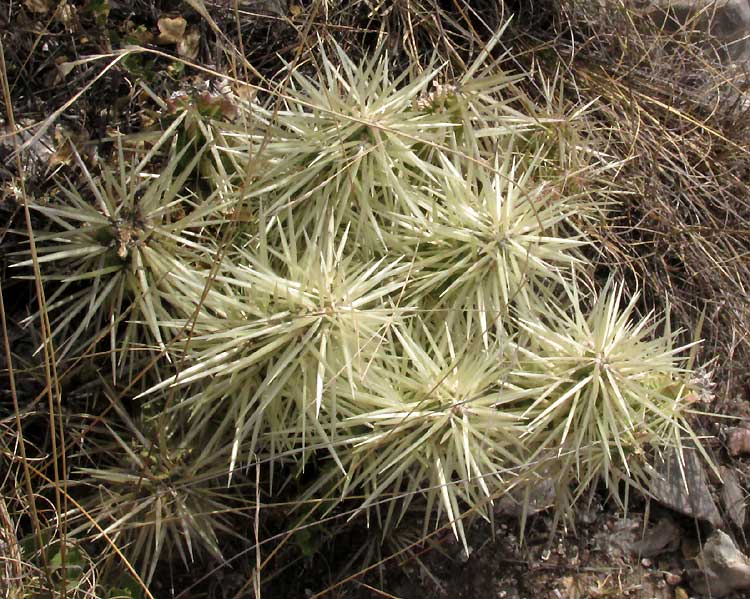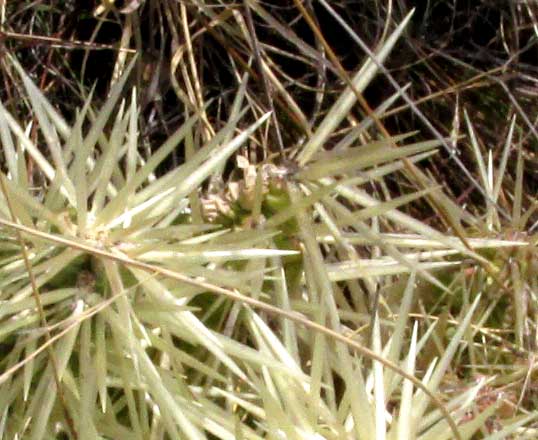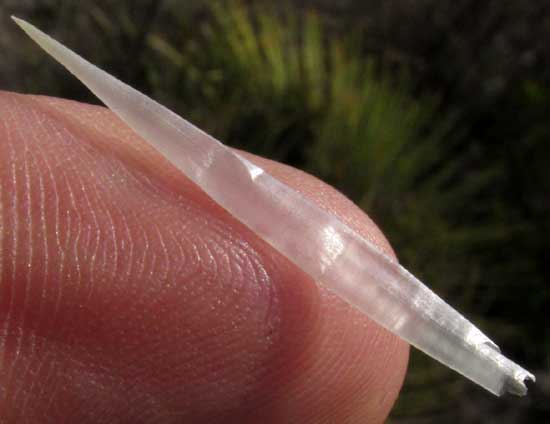Excerpts from Jim Conrad's
Naturalist Newsletter
from the May 24, 2018 Newsletter issue with notes from a camping trip during the first week on April, 2018 in the mountains east of Saltillo, Coahuila, Northeastern MÉXICO
SPINIEST OF CACTI
On April 5th in the mountains east of Saltillo, I started out hiking on a valley floor, and climbed a small limestone mountain that was grassy and scrubby at its base, but forested on top. Toward the top, at ±7000 feet in elevation (2100m), where trees were just starting to appear, I found commonly growing what must be the spiniest of all cacti. If it were any spinier surely not enough sunlight could penetrate the spines for photosynthesis to take place. Below, you can see one of these amazing plants:

A close-up look of some spine clusters is seen below:

If you could see the cactus's green body, it would consist of cylindrical stems about as thick as wieners spreading from a common base. Most stems only grew tall enough to stab their spines into your calf if you backed into one. I've done that, and can report that there's something else special about the spines, beyond their abundance. And that is that if a spine sticks you, a hollow sheath that was enveloping the spine come off, and stays stuck in your skin even when the spine withdraws. A hollow spine-sheath is shown below:

Scraping your thumbnail across the sheath's surface, you can feel that it's a little rough, and when you pull the sheath out of your skin you quickly realize that the roughness is caused by backward-pointing projections that tear at your flesh as the sheath is being pulled out.
Despite the cactus producing no flowers at this season, I could see that no other such super-spiny cactus of this shape, size and form existed in the region, using the excellent, well illustrated, Spanish-language Guía de Cactáceas del Estado de Coahuila by Alfredo Flores, {which was}freely available on the Internet.
It's CYLINDROPUNTIA TUNICATA, in the online Flora of North America referred to as the Sheathed Cholla. Its presence in the Flora is due to the species occurring in the limited part of southwestern Texas occupied by the Chihuahuan Desert, from 1500 to 2300m in elevation (4900-7550ft). From Texas the species continues on south and west throughout the Chihuahuan Desert of northern Mexico, plus it 's invasive in numerous other countries, apparently introduced by humans and livestock shipments.
The Flora of North America makes the interesting point that the Sheathed Cholla's fruits usually are sterile. Still, in much of norther Mexico the species is abundant, despite large parts of its population being wiped out by ranching and urban sprawl. Apparently it spreads mostly vegetatively, its broken-off joints rooting and forming new plants.
Sometimes Sheathed Cholla is planted to form impenetrable hedges around plantations. In Hawaii where the plant has been introduced, Hawaiians have been documented using juice from the cactus's stems and roots for constipation. Up north in cactus gardens, Sheathed Cholla often is regarded as desirable because during those seasons when no cactus is flowering or fruiting, this species at least catches the eye with its remarkable spines.